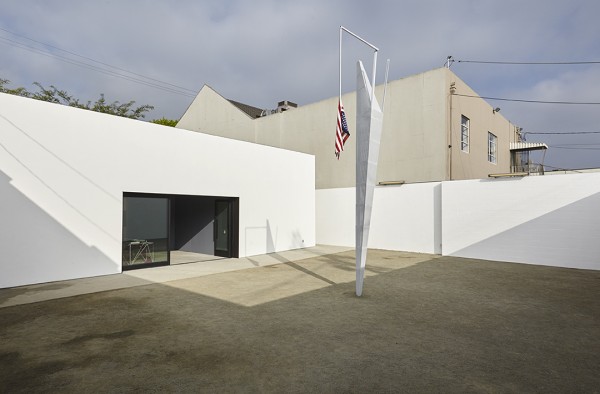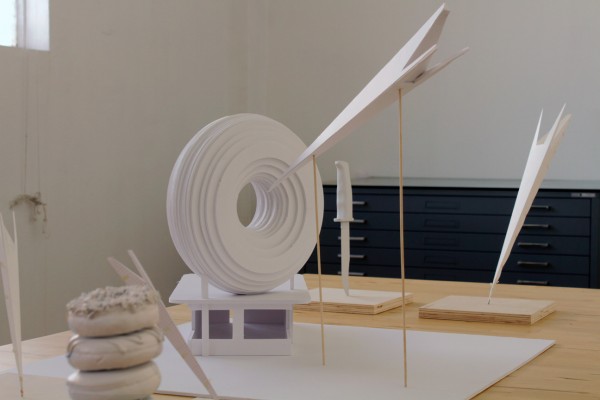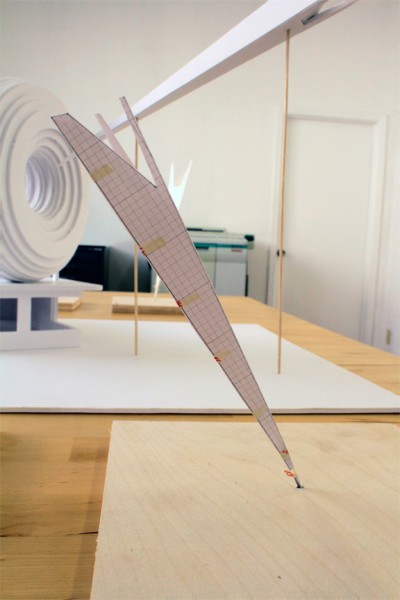Inverted Capitol Spire and Programmatic Architecture Displacements at VSF and LACA
Inverted Capitol Spire: Programmatic Architecture Displacement #5, steel, cotton, 2014
Various Small Fires, Los Angeles, through Nov. 8, 2014
VSF is pleased to inaugurate its outdoor gallery and sound corridor with the new site-specific installation Inverted Capitol Spire, Programmatic Architecture Displacement 5 and the five-channel sound-piece “Inversion V” by Los Angeles-based artist Scott Benzel. This is his first show with the gallery.
Benzel’s work often examines the boundaries between curatorial and artistic practices, as well as popular and high culture, through the selection, re-contextualization, and re-examination of subjects categorized within the twin spheres of ‘high’ and ‘low.’ For this exhibition, the artist approaches two of Los Angeles’ most definitive cultural icons–the Capitol Records building and The Beach Boys–using the musical and architectonic concept of inversion.
Conceived of by the 24-year-old graduate student Lou Naidorf for the architectural firm Welton Beckett, the original design for the Capitol Records building suggests an inverted (skyward) stylus atop a stack of records, capped with a light that regularly pulses out Morse code for ‘Hollywood.’ After its completion in 1956, it became both the world’s first circular office building and a novelty construction that visually established the growing record company as a formidable West Coast presence. In In- verted Capitol Spire, Programmatic Architecture Displacement 5, Benzel turns a 1/4-scale steel replica of this blinking SoCal landmark earthward, reassuming its original symbolism as a phonographic needle. Meanwhile, “Inversion V” reworks Benzel’s string-quintet composition based on The Beach Boys’ 1969 Capitol Records’ release “Never Learn Not to Love” with both the rhythmic drumming of Morse code for Hollywood and abstracted compositions inspired by field recordings from Los Angeles’ streets.
Both Benzel’s bold anti-monument and tempermental sound-piece confront an alternate history of Los Angeles’ flippant culture industry. “Never Learn Not to Love,” for example, was the last song released by America’s clean cut favorites The Beach Boys before they left Capitol Records later that year amidst a blaze of litigation. In this manner, Inverted Capitol Spire, Programmatic Architecture Displacement 5 and “Inversion V” underscore the city’s routine employment of modernist and technological images and metaphors, thereby complicating its attending mythologies with an ominous lilt.
Scott Benzel (b. 1968) has presented exhibitions or performed at the Los Angeles County Museum of Art; the Museum Of Contemporary Art Los Angeles; the Hammer Museum, Los Angeles, CA; the Con- temporary Art Museum, St. Louis, MO; LAXART, Los Angeles, CA; Human Resources, Los Angeles, CA; Public Fiction, Los Angeles, CA; Ballroom Marfa, Marfa, TX; Performa 09, New York, NY; Macca- rone, New York, NY; Benzel has curated shows at the MAK Center/Schindler House, Los Angeles and the Welcome Inn, Eagle Rock, CA, as part of Pacific Standard Time organized by the Getty Museum, among others.
http://www.vsf.la/scott-benzel/
Programmatic Architecture Displacements 6 and 7 at Los Angeles Contemporary Archives, architectural maquettes, 2014
n 2010, Benzel presented Inversions I-IV at Kathryn Andrews’ artist-run space Apartment 2. Consisting of several videos, photographic ephemera, hand-lathed phonographic record lacquers, and live string quartet, the show examined Inversion as a musical form (Inversion in music occurs when a musical score is played upside-down) as well as an architectonic phenomenon. The show included inverted videos of examples of Programmatic or Mimetic Architecture from around Los Angeles including a cellphone tower disguised as a palm tree and the Capitol Records Spire- a now-iconic piece of high modernist architecture based on the graduate school drawings of a young architect named Lou Naidorf for the firm of Welton Beckett-which suggests an inverted (skyward) phonographic stylus atop a stack of records.
In the new work, Benzel suggests examples of displacement in iconic Los Angeles Programmatic architecture. Freud defined displacement as a shift in emphasis from something important to something unimportant or the replacement of something unacceptable by an allusion. He saw displacement at work in jokes as well as in metaphor and metonymy.
Benzel here enacts a joke, a somewhat silly, obscene joke: these small maquettes- anti-monumental in the extreme- propose the ‘coupling’ of the spire- emblematic of ‘high’ mid-20th Century culture with another mimetic icon of Los Angeles architecture (this time of ‘low’ culture) the massive yellow-brown donut atop Randy’s Donuts. The obvious sexual metaphor and the admixture of the ‘high’ and ‘low’ reflect architect Naidorf’s position on his own spire:
“A lot of critics thought it would go the way of the Tail o’ the Pup,” says Naidorf, “that it was just another silly L.A. building. So it’s ironic that it’s become so famous.”
Los Angeles Contemporary Archive (LACA) is located at 2245 E. Washington, which houses Ghebaly Gallery, Dope Press, 2nd Cannon Press, and the Fahrenheit project by the FLAX Foundation.


